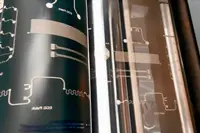 Engineers at Oregon State University claim to have made a breakthrough in understanding the physics of photonic ‘sintering’, which could lead to advances in solar cells, flexible electronics, sensors and other high-tech products printed onto something as simple as a sheet of paper or plastic.
Engineers at Oregon State University claim to have made a breakthrough in understanding the physics of photonic ‘sintering’, which could lead to advances in solar cells, flexible electronics, sensors and other high-tech products printed onto something as simple as a sheet of paper or plastic.
Sintering is the fusing of nanoparticles to form a solid, functional thin-film that can be used for many purposes, and the process could have considerable value for new technologies. Photonic sintering has the possible advantage of higher speed and lower cost, compared to other technologies for nanoparticle sintering.
The OSU experts discovered that previous approaches to understand and control photonic sintering had been based on a flawed view of the basic physics involved, which had led to a gross overestimation of product quality and process efficiency.
Based on the new perspective of this process the researchers now believe they can create high quality products at much lower temperatures, at least twice as fast and with 10 times more energy efficiency.
"Lower temperature is a real key," Rajiv Malhotra, an assistant professor of mechanical engineering in the OSU College of Engineering, said. "To lower costs, we want to print these nanotech products on things like paper and plastic, which would burn or melt at higher temperatures. We now know that is possible, and how to do it. We should be able to create production processes that are both fast and cheap, without a loss of quality."
Products that could evolve from the research include solar cells, gas sensors, radiofrequency identification tags, and a range of flexible electronics. Wearable biomedical sensors could emerge, along with new sensing devices for environmental applications.
The researchers say that it should be possible to scale up the process to large manufacturing levels for industrial use.
Author
Tom Austin-Morgan
Source: www.newelectronics.co.uk

